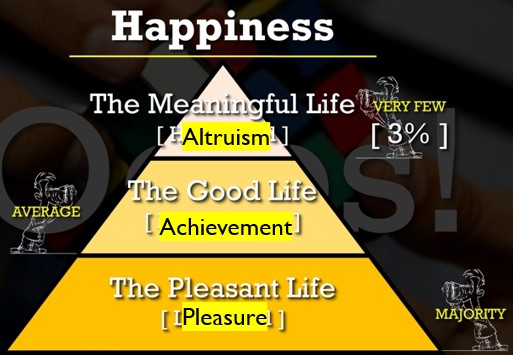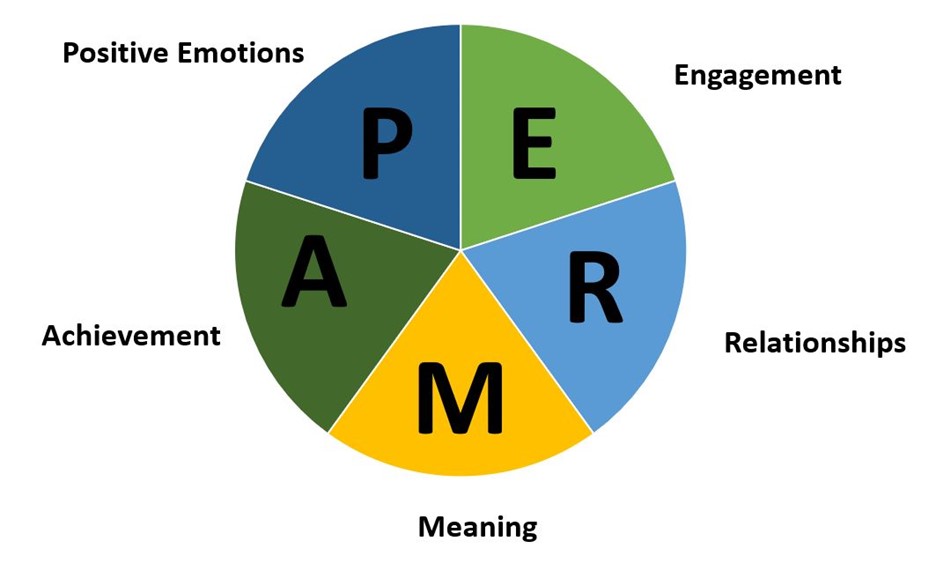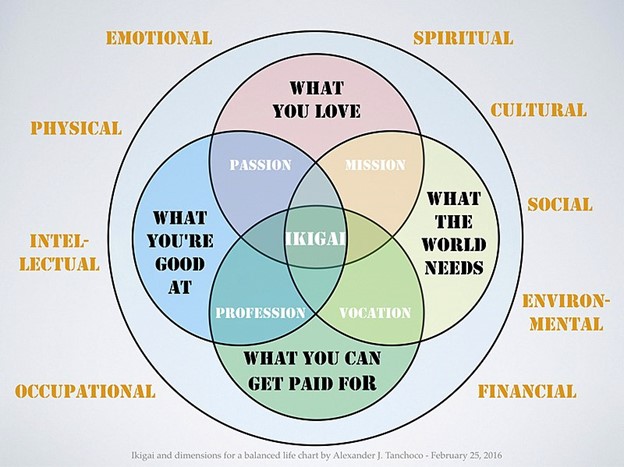Unit 1 The Beginning
Overview
Welcome to Foundations 102 - Human Flourishing. In this first unit we will begin our journey toward personal flourishing with defining terms. Flourishing, wellbeing and happiness are all familiar terms to us however they are notoriously difficult concepts to fully describe and define. For example flourishing is neither the absence of illness and suffering nor the pure presence of happiness and joy.
In this unit we will start with a brief overview of various academic disciplines, perspectives and theories that aim to explain these terms and at the same time try to incorporate our personal understanding of them. We hope you enjoy the journey.

Learning Outcomes
When you have completed this unit, you should be able to:
- Explore various models of wellbeing both from literature and your peers
- Define and represent your personal experience of wellbeing
- Explore various facets of human happiness
- Experience and reflect on a personal one-week practice of gratitude
Activity Checklist
Here is a checklist of learning activities you will benefit from in completing this unit. You may find it useful for planning your work. Note that all Learning Lab activities build toward the final portfolio in the course.
Learning Activities
- Watch the video The Good Life and Course Perspectives (20 minutes)
- Post a picture of what the “Good Life” means to you
- Watch the video Living Well: A Philosophical Perspective (15 minutes)
- Read two articles that review the literature on wellbeing
- Write a personal definition to wellbeing and post in the forum
- Watch the video The Science of Happiness (27 mins)
- Watch the video on Positive Psychology and complete the embedded quiz (5 mins)
- Learning Lab: Instructor and course introductions, as well as Unit 1 activities
Assessment
- Review and Integration assignment: Bubble Map of your wellbeing
- Review and Integration assignment: Complete the Wellbeing Survey
- Personal Application Assignment: Gratitude
1.1 What is the good life?
We will start this course in wellbeing at a macro level or from a big picture point of view. Most of us have an already developed sense of what the good life is, however it is usually limited to our personal experience. The problem with personal experience is it does not consider different experiences, contexts or perspectives. In this unit we hope to expose you to the broad landscape of the science of wellbeing as well as have you articulate your own understandings of wellbeing.
Activity: Course Perspectives and Introduction to the Good life
Watch the video The Good Life and Course Perspectives (20 mins). As you watch, consider…both your understanding of flourishing and what areas are new to your thinking.
Watch: The Good Life and Course Perspectives
Questions to Consider
After watching the video above, consider the following questions:
- Which description of wellbeing makes the most sense to you?
- Do you feel like an adult?
- What is your personal experience with wellbeing? Has it been a challenge for you, or is it something you have given little thought to?
- What would personal growth mean to you in the next month, year or decade?
Note: that the learning activities in this course are ungraded, unless specified. They are designed to help you succeed in your assessments in this course, so you are strongly encouraged to complete them.
Activity: What is the Good Life?
Post a picture of what the “Good Life” means to you. Submit your picture to the forum
Activity: Wellbeing Perspectives
Watch the video Living Well: A Philosophical Perspective (15 mins) In this video you will see how Western philosophy has tried to deal with the fundamental tension of pleasure vs. meaning in life.
Watch: Living Well: A Philosophical Perspective
After watching the video, consider the following questions:
- Which Greek philosopher makes more sense: Epicurus or Aristotle?
- What do you think of Aristotle’s view of being human?
- Which side of pleasure and meaning divide do you lean toward?
- How do you sacrifice your personal rights for the good of the greater society?
Activity: Wellbeing Literature
Read these two articles that review the literature on wellbeing. They will give you a brief overview of the historical and theoretical science of wellbeing.
- A Phenomenological Perspective on Subjective Well Being: from Myth to Science, by Aleksandra Drakulic - This article discusses the history of subjective wellbeing.
- Theories of Well Being, by Roger Crisp – this article surveys the various conceptualizations of wellbeing
As you read, consider how these articles relate to your understanding and definition of well-being.
Activity: Personal Definition of Wellbeing
Write a personal definition to wellbeing and post in the forum. Here is where you get to express your personal experience and understanding of wellbeing. You will also get to see your classmates understanding of the topic.
Instructions:
- Part 1 - Write a 50 word personal definition of wellbeing which incorporates the following concepts: happiness (pleasure), meaning (purpose), health, virtue (ethics) and suffering (pain) and spirituality. Note that these are topics we will explore throughout the rest of the course. Post your response in the Unit 1 Discussion Forum in Moodle.
- Part 2 - Once you have completed this, read some of your classmates definitions. If you look ahead at the final portfolio (which is the final exam in this course) you will see this is the first question. This unit will help you develop your answer to the first question on the final portfolio.
If you are new to posting in forums, here are some instructions:
- Start by click the “Add new discussion topic” button.
- In the editor, add your content. Click on the image icon to upload an image. If you don’t see an image icon in the editor bar, click the toggle button (first row, first icon) to expand the options.
- To reply to others, you will notice on the bottom right of their post a “reply” link to click.
1.2 What is Happiness?
One of the central concepts in wellbeing is happiness. Happiness often appears fickle or just out of reach for many; however, we will discuss strategies for happiness, which are often counter intuitive. In this topic we will explore what empirical science has revealed about happiness. The underlying message is summed up in a quote from Mihaly Csikzentmihaylyi, one of the founders of positive psychology “Contrary to what most of us believe, happiness does not simply happen to us. It is something that we make happen” (reference?)
There are a couple key concepts that you will be introduced to in the resources below. First, Seligman’s ideas of the “Good life” and the “Meaningful Life”.

Figure 1: Modified from Martin Seligman’s book Authentic Happiness: Using the New Positive Psychology to Realize Your Potential for Lasting Fulfillment
He later modified it into the the PERMA model of wellbeing.

Figure 2: Seligman’s PERMA Model of Well-being from Debbie Plouma on Wikimedia
A final concept we’ll discuss in happiness research is the idea of IKIGAI which is a Japanese concept referring to something that gives a person a sense of purpose, a reason for living. Wellbeing is at the center of the venn diagram.

Figure 3: Ikigai chart with the dimensions for living a balanced life by Alex Tanchoco on Wikimedia Commons.
Activity: Happiness Resources
Watch the video The Science of Happiness (27 mins). In this video we consider the benefits of happiness, what makes us happy, and the science of positive psychology.
Watch: The Science of Happiness
Questions to Consider
After completing the activities above, consider the following questions:
- How important is your own personal happiness?
- What do you do to make yourself happy?
- What do you think will make you the most happy?
- Where do expend a lot of effort to achieve something you want (remember Seligman’s “Good life” from the video)?
- Where do you sacrifice for others happiness (e.g. Seligman’s “Meaningful Life”)?
- Do you think there is anything missing from the PERMA model of positive psychology?
- Do you have an IKIGAI (reason for being) practice in your life?
Unit 1 Summary
In this first unit, you have had the opportunity to learn about…
- Various definitions, frames, and theories for wellbeing
- What is happiness, what makes us happy, and the science of happiness
Assessment
- Review and Integration assignment: Bubble Map of your wellbeing
- Review and Integration assignment: Wellbeing Survey
- Personal Application Assignment: Gratitude Practice
Review and Integration assignment: Bubble Map of your Wellbeing
We all have a conceptualization of what wellbeing is and how you achieve it. This conceptualization is fundamental to understanding our personal approach to flourishing. In this assignment we will have you draw or map out the elements with their relationships in something called a bubble map.
Watch the video below and then create your own bubble map of wellbeing. Then upload your bubble map picture (screen shot or photo) to the forum at the bottom of the page, with a 50 word explanation of the map (particularly the lines of relationships between the bubbles).
Review and Integration assignment: Wellbeing Survey
Instructions:
The wellbeing survey is designed for a two fold purpose. First it will show you the scope of topics in this course, and second reveal your personal previous experience and perspectives on those topics. Also in the middle of the survey, Question #6 you will find a “The Satisfaction with Life Scale”, add up your total score for question #6 and then you will find a scoring document in the drop box below for assessing your score. You will complete “The Satisfaction with Life Scale” again at the end of the course for a pre and post comparison. These pre and post scores will go into part 3 of the Final Portfolio. Go ahead and complete the Wellbeing survey document below, then save it to your computer and finally upload the completed survey back to the dropbox at the bottom of this page.
Downloads:
Personal Application Assignment 1: Gratitude
The personal application assignments (PAA) are an extension of our underlying theme of embodied cognition. Wellbeing is not a thought experiment – it is a practice, or more accurately, a series of practices. These practices will all be empirical, meaning scientific evidence supports their positive effects. This first assignment comes from the field of positive psychology, gratitude. Research has demonstrated that taking time to be grateful has a significant effect on our sense of happiness and general well-being. With this as the goal, you have two choices of how to full this first practice
Choose one of the following:
- Write a letter (250 words minimum) of appreciation to someone important in your life and then read it to them in person, on the phone, on Zoom, Facetime, etc. Then reflect on the impact of this experience (see Gratitude-Visit-Letter document)
- Keep a one-week gratitude journal where you record between 3-5 things you are grateful for each day for five days (see Gratitude Journal document).
See video explanations and assignment documents below.
Watch: PAA Gratitude - Letter of Appreciation
Downloads:
- Doc: Gratitude Visit Letter
- Doc: Gratitude Journal
Check your Learning
Before you move on to the next unit, you may want to check to make sure that you are able to:
- Articulate a personal understanding of wellbeing
- Explore various models of wellbeing both from literature and your peers.
- Explore various facets of human happiness
- Experience and reflect on a personal one-week practice of gratitude
Before you move on, don’t forget to:
- Submit Review and Integration assignment 1.1: Wellbeing Survey
- Part 1: Upload Wellbeing Survey to the dropbox
- Part 2: Wellbeing Forum - video response to three questions
- Part 1: Upload Wellbeing Survey to the dropbox
- Submit PAA #1 Gratitude